MoO3 Interlayer Modification on the Electronic Structure of Co/BP Interface
Abstract
1. Introduction
2. Experimental Method
3. Results and Discussion
4. Conclusions
Supplementary Materials
Author Contributions
Funding
Data Availability Statement
Conflicts of Interest
References
- Zhang, M.; Wu, Q.; Zhang, F.; Chen, L.L.; Jin, X.X.; Hu, Y.W.; Zheng, Z.; Zhang, H. 2d Black Phosphorus Saturable Absorbers for Ultrafast Photonics. Adv. Opt. Mater. 2019, 7, 1800224. [Google Scholar] [CrossRef]
- Liu, H.; Hu, K.; Yan, D.; Chen, R.; Zou, Y.; Liu, H.; Wang, S. Recent Advances on Black Phosphorus for Energy Storage, Catalysis, and Sensor Applications. Adv. Mater. 2018, 30, e1800295. [Google Scholar] [CrossRef] [PubMed]
- Zhao, Y.; Chen, Y.; Zhang, Y.H.; Liu, S.F. Recent Advance in Black Phosphorus: Properties and Applications. Mater. Chem. Phys. 2017, 189, 215–229. [Google Scholar] [CrossRef]
- Ren, X.L.; Lian, P.C.; Xie, D.L.; Yang, Y.; Mei, Y.; Huang, X.R.; Wang, Z.R.; Yin, X.T. Properties, Preparation and Application of Black Phosphorus/Phosphorene for Energy Storage: A Review. J. Mater. Sci. 2017, 52, 10364–10386. [Google Scholar] [CrossRef]
- Lei, W.; Liu, G.; Zhang, J.; Liu, M. Black Phosphorus Nanostructures: Recent Advances in Hybridization, Doping and Functionalization. Chem. Soc. Rev. 2017, 46, 3492–3509. [Google Scholar] [CrossRef]
- Li, L.; Yu, Y.; Ye, G.J.; Ge, Q.; Ou, X.; Wu, H.; Feng, D.; Chen, X.H.; Zhang, Y. Black Phosphorus Field-Effect Transistors. Nat. Nanotechnol. 2014, 9, 372–377. [Google Scholar] [CrossRef]
- Li, L.; Engel, M.; Farmer, D.B.; Han, S.J.; Wong, H.S. High-Performance P-Type Black Phosphorus Transistor with Scandium Contact. Acs Nano 2016, 10, 4672–4677. [Google Scholar] [CrossRef]
- Engel, M.; Steiner, M.; Avouris, P. Black Phosphorus Photodetector for Multispectral, High-Resolution Imaging. Nano Lett. 2014, 14, 6414–6417. [Google Scholar] [CrossRef]
- Youngblood, N.; Chen, C.T.; Koester, S.J.; Li, M. Waveguide-Integrated Black Phosphorus Photodetector with High Responsivity and Low Dark Current. Nat. Photonics 2015, 9, 247. [Google Scholar] [CrossRef]
- Buscema, M.; Groenendijk, D.J.; Steele, G.A.; van der Zant, H.S.; Castellanos-Gomez, A. Photovoltaic Effect in Few-Layer Black Phosphorus Pn Junctions Defined by Local Electrostatic Gating. Nat. Commun. 2014, 5, 4651. [Google Scholar] [CrossRef]
- Dai, J.; Zeng, X.C. Bilayer Phosphorene: Effect of Stacking Order on Bandgap and Its Potential Applications in Thin-Film Solar Cells. J. Phys. Chem. Lett. 2014, 5, 1289–1293. [Google Scholar] [CrossRef] [PubMed]
- Yan, H.G.; Li, X.S.; Chandra, B.; Tulevski, G.; Wu, Y.Q.; Freitag, M.; Zhu, W.J.; Avouris, P.; Xia, F.N. Tunable Infrared Plasmonic Devices Using Graphene/Insulator Stacks. Nat. Nanotechnol. 2012, 7, 330–334. [Google Scholar] [CrossRef] [PubMed]
- Tran, V.; Soklaski, R.; Liang, Y.F.; Yang, L. Layer-Controlled Band Gap and Anisotropic Excitons in Few-Layer Black Phosphorus. Phys. Rev. B 2014, 89, 235319. [Google Scholar] [CrossRef]
- Kou, L.; Frauenheim, T.; Chen, C. Phosphorene as a Superior Gas Sensor: Selective Adsorption and Distinct I-V Response. J. Phys. Chem. Lett. 2014, 5, 2675–2681. [Google Scholar] [CrossRef] [PubMed]
- Sui, X.L.; Si, C.; Shao, B.; Zou, X.L.; Wu, J.; Gu, B.L.; Duan, W.H. Tunable Magnetism in Transition-Metal-Decorated Phosphorene. J. Phys. Chem. C 2015, 119, 10059–10063. [Google Scholar] [CrossRef]
- Kamalakar, M.V.; Madhushankar, B.N.; Dankert, A.; Dash, S.P. Low Schottky Barrier Black Phosphorus Field-Effect Devices with Ferromagnetic Tunnel Contacts. Small 2015, 11, 2209–2216. [Google Scholar] [CrossRef]
- Hong, Q.; Xu, W.; Zhang, J.; Zhu, Z.; Yuan, X.; Qin, S. Optical Activity in Monolayer Black Phosphorus Due to Extrinsic Chirality. Opt. Lett. 2019, 44, 1774–1777. [Google Scholar] [CrossRef]
- Liu, B.; Xie, H.; Wang, S.; Zhao, Y.; Liu, Y.; Niu, D.; Gao, Y. Effect of MoO3 Buffer Layer on the Electronic Structure of Al–Bp Interface. J. Phys. D Appl. Phys. 2022, 55, 364005. [Google Scholar] [CrossRef]
- Liu, B.X.; Xie, H.P.; Liu, Y.Q.; Wang, C.; Wang, S.T.; Zhao, Y.; Liu, J.X.; Niu, D.M.; Huang, H.; Gao, Y.L. Electronic Structure and Spin Polarization of Co/Black Phosphorus Interface. J. Magn. Magn. Mater. 2020, 499, 166297. [Google Scholar] [CrossRef]
- Liu, B.X.; Xie, H.P.; Niu, D.M.; Huang, H.; Wang, C.; Wang, S.T.; Zhao, Y.; Liu, Y.Q.; Gao, Y.L. Interface Electronic Structure between Au and Black Phosphorus. J. Phys. Chem. C 2018, 122, 18405–18411. [Google Scholar] [CrossRef]
- Sun, G.J.; Shahid, M.; Fei, Z.P.; Xu, S.D.; Eisner, F.D.; Anthopolous, T.D.; McLachlan, M.A.; Heeney, M. Highly-Efficient Semi-Transparent Organic Solar Cells Utilising Non-Fullerene Acceptors with Optimised Multilayer MoO3/Ag/MoO3 Electrodes. Mater. Chem. Front. 2019, 3, 450–455. [Google Scholar] [CrossRef]
- Xiang, D.; Han, C.; Wu, J.; Zhong, S.; Liu, Y.; Lin, J.; Zhang, X.A.; Hu, W.P.; Özyilmaz, B.; Neto, A.H.C.; et al. Surface Transfer Doping Induced Effective Modulation on Ambipolar Characteristics of Few-Layer Black Phosphorus. Nat. Commun. 2015, 6, 6485. [Google Scholar] [CrossRef] [PubMed]
- Chu, X.B.; Guan, M.; Zhang, Y.; Li, Y.Y.; Liu, X.F.; Zeng, Y.P. Ito-Free and Air Stable Organic Light-Emitting Diodes Using MoO3:Ptcda Modified Al as Semitransparent Anode. RSC Adv. 2013, 3, 9509–9513. [Google Scholar] [CrossRef]
- Latif, H.; Zahid, R.; Rasheed, S.; Sattar, A.; Rafique, M.S.; Zaheer, S.; Shabbir, S.A.; Javed, K.; Usman, A.; Amjad, R.J.; et al. Effect of Annealing Temperature of MoO3 Layer in MoO3/Au/MoO3 (Mam) Coated Pbs Qds Sensitized Zno Nanorods/Fto Glass Solar Cell. Sol. Energy 2020, 198, 529–534. [Google Scholar] [CrossRef]
- Wang, F.; Hu, F.; Zhang, X.; Xu, H. In Situ Photoelectron Spectroscopy Investigation of Interface Coupling between Metals and MoO3 Thin Films. Surf. Rev. Lett. 2016, 24, 1750042. [Google Scholar] [CrossRef]
- Lee, T.H.; Kim, S.Y.; Jang, H.W. Black Phosphorus: Critical Review and Potential for Water Splitting Photocatalyst. Nanomaterials 2016, 6, 194. [Google Scholar] [CrossRef]
- Peelaers, H.; Chabinyc, M.L.; Van de Walle, C.G. Controlling N-Type Doping in MoO3. Chem. Mater. 2017, 29, 2563–2567. [Google Scholar] [CrossRef]
- Liu, X.L.; Wang, C.G.; Wang, C.C.; Irfan, I.F.; Gao, Y.L. Interfacial Electronic Structures of Buffer-Modified Pentacene/C-60-Based Charge Generation Layer. Org. Electron. 2015, 17, 325–333. [Google Scholar] [CrossRef]
- Biesinger, M.C.; Payne, B.P.; Grosvenor, A.P.; Lau, L.W.M.; Gerson, A.R.; Smart, R.S.C. Resolving Surface Chemical States in Xps Analysis of First Row Transition Metals, Oxides and Hydroxides: Cr, Mn, Fe, Co and Ni. Appl. Surf. Sci. 2011, 257, 2717–2730. [Google Scholar] [CrossRef]
- Biesinger, M.C.; Payne, B.P.; Lau, L.W.M.; Gerson, A.; Smart, R.S.C. X-ray Photoelectron Spectroscopic Chemical State Quantification of Mixed Nickel Metal, Oxide and Hydroxide Systems. Surf. Interface Anal. 2009, 41, 324–332. [Google Scholar] [CrossRef]
- Salaneck, W.R.; Seki, K.; Kahn, A.; Pireaux, J.-J. Conjugated Polymer and Molecular Interfaces: Science and Technology for Photonic and Optoelectronic Application; CRC Press: New York, NY, USA, 2001. [Google Scholar]
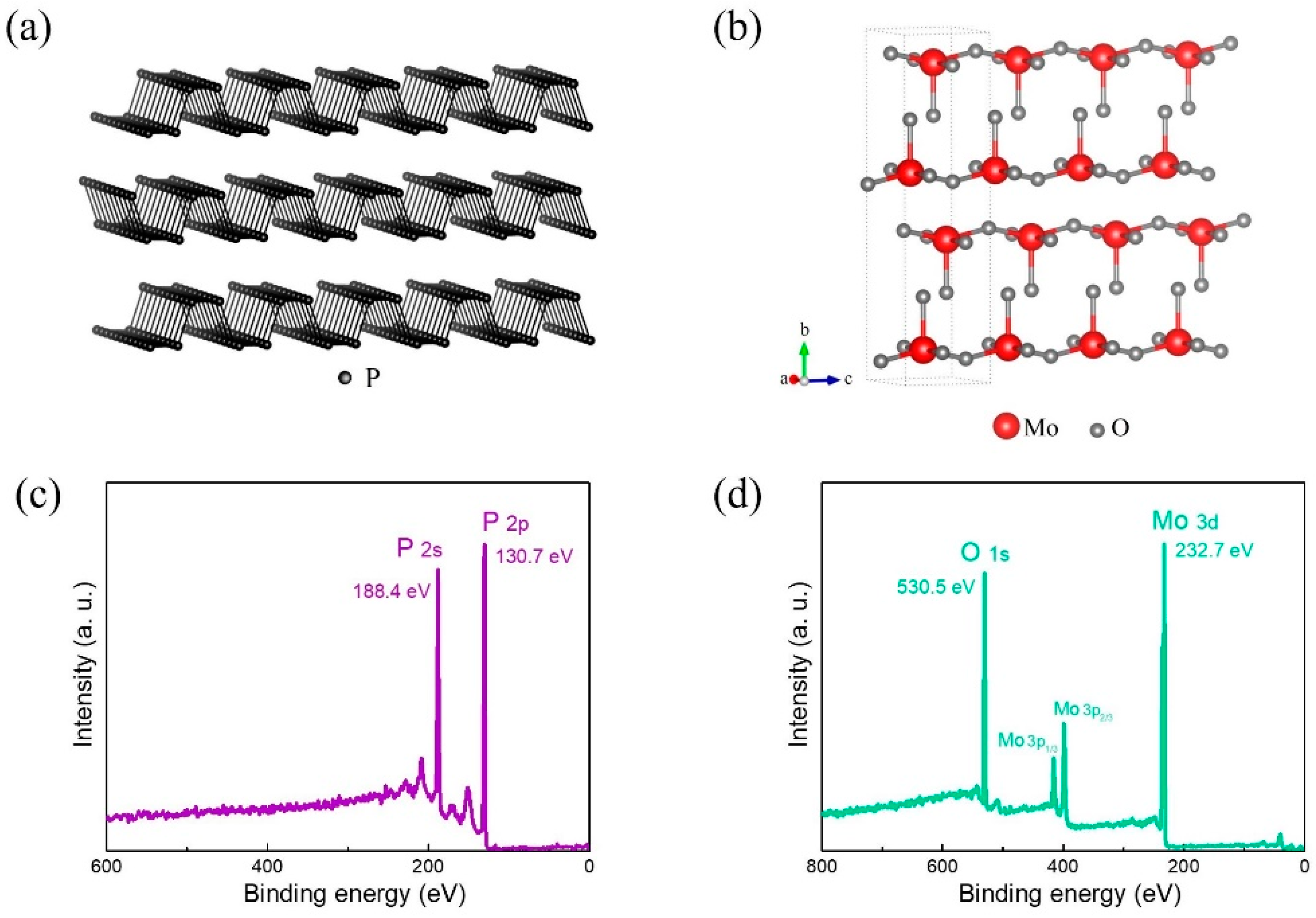
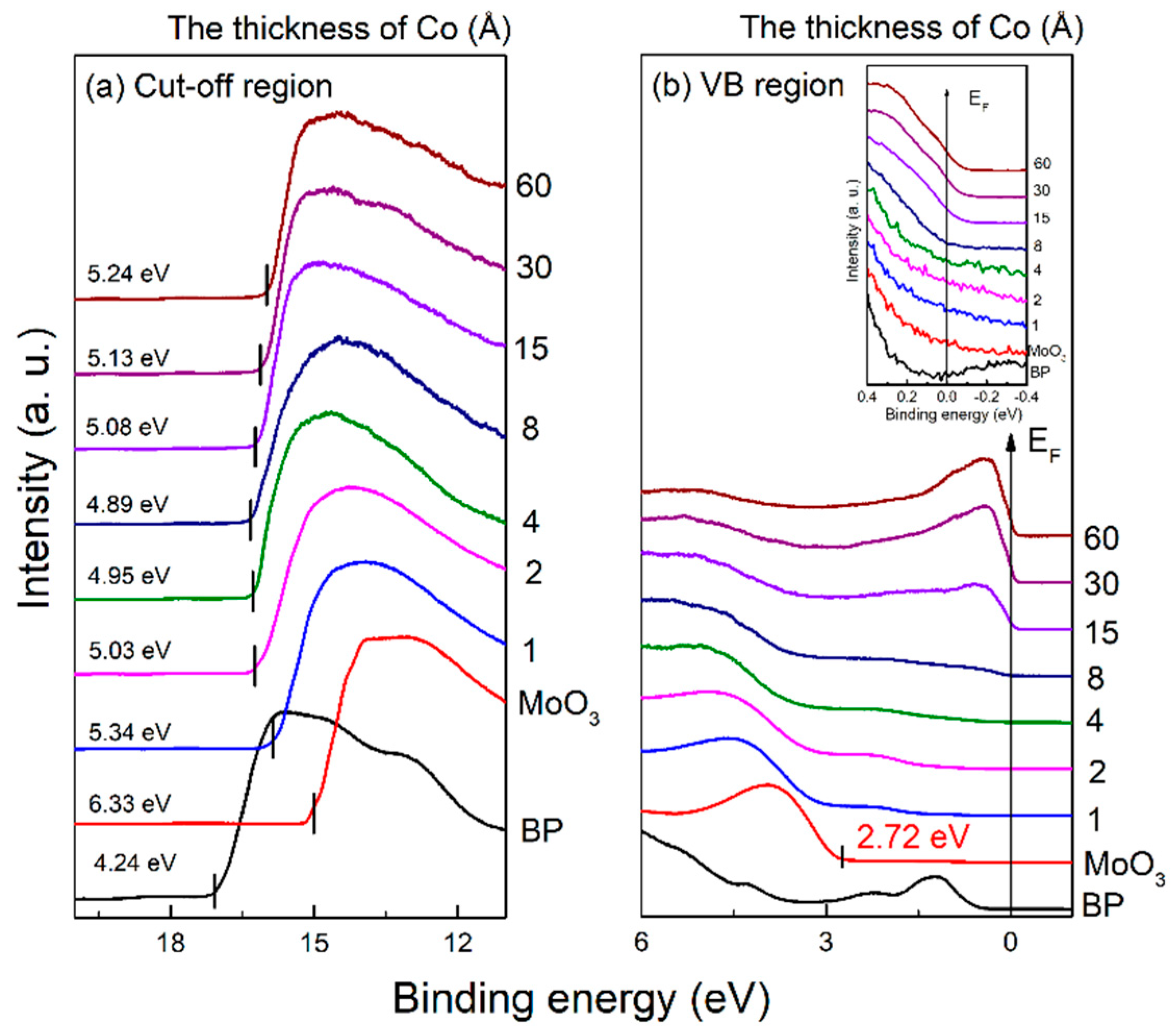
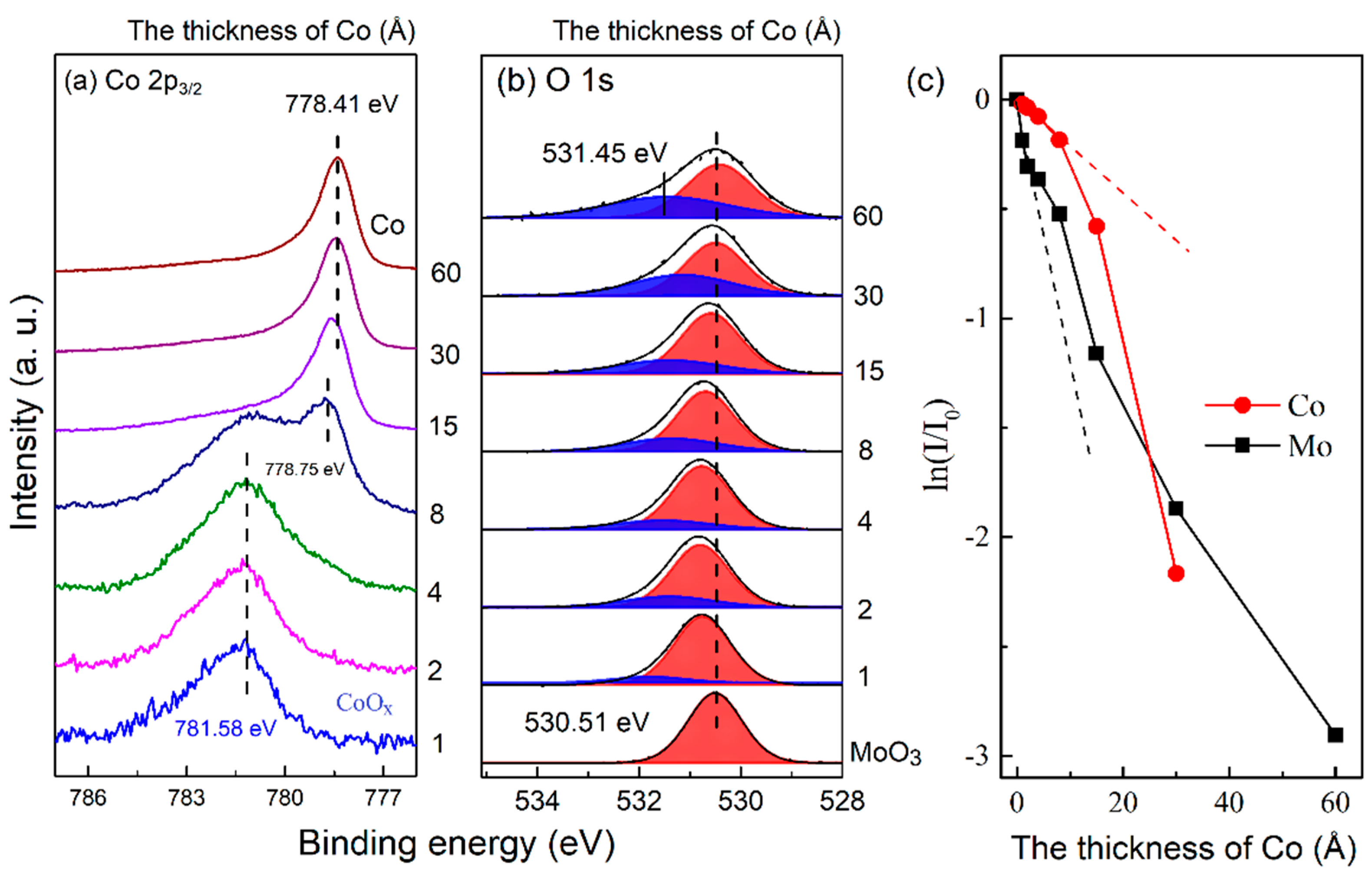
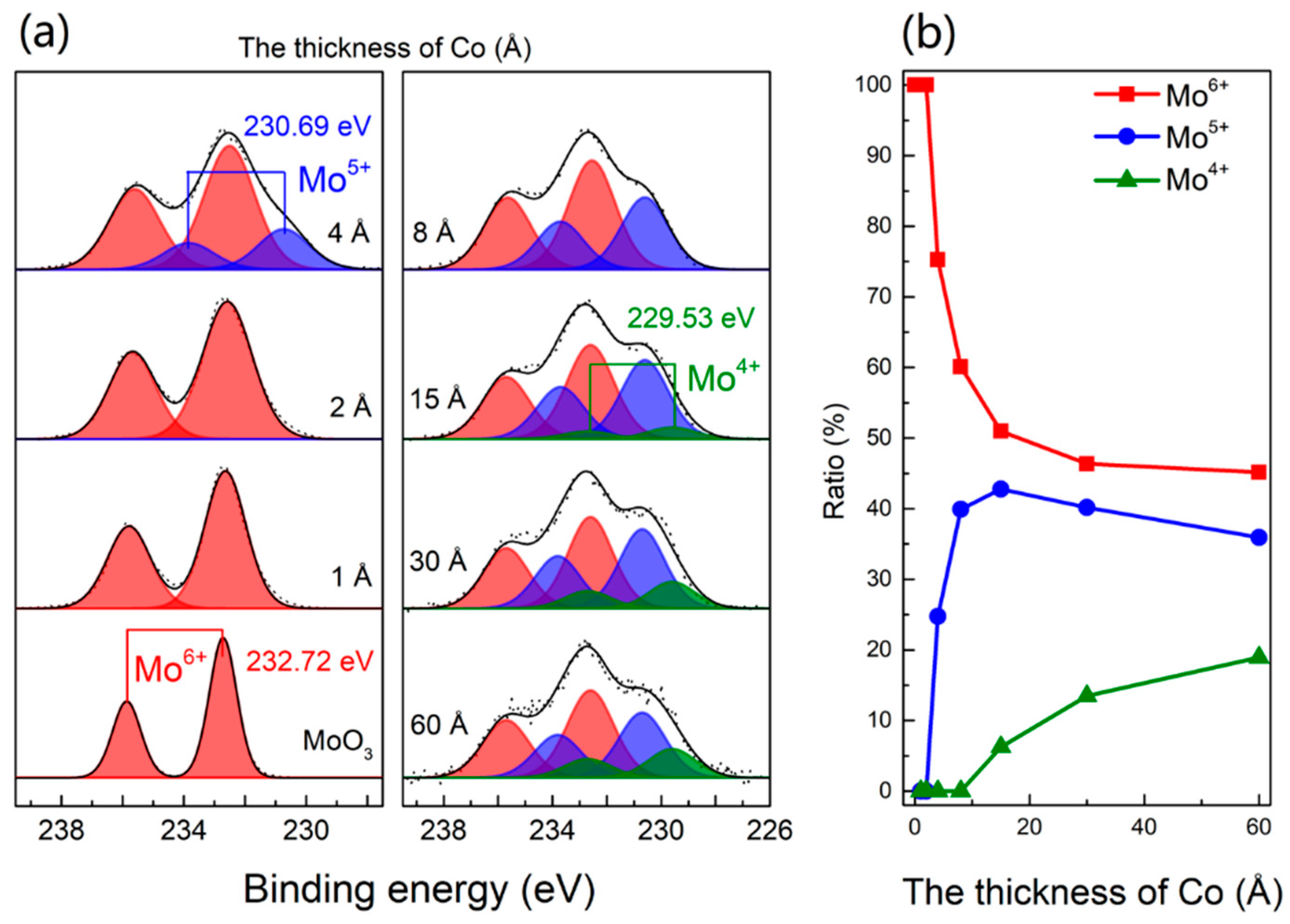
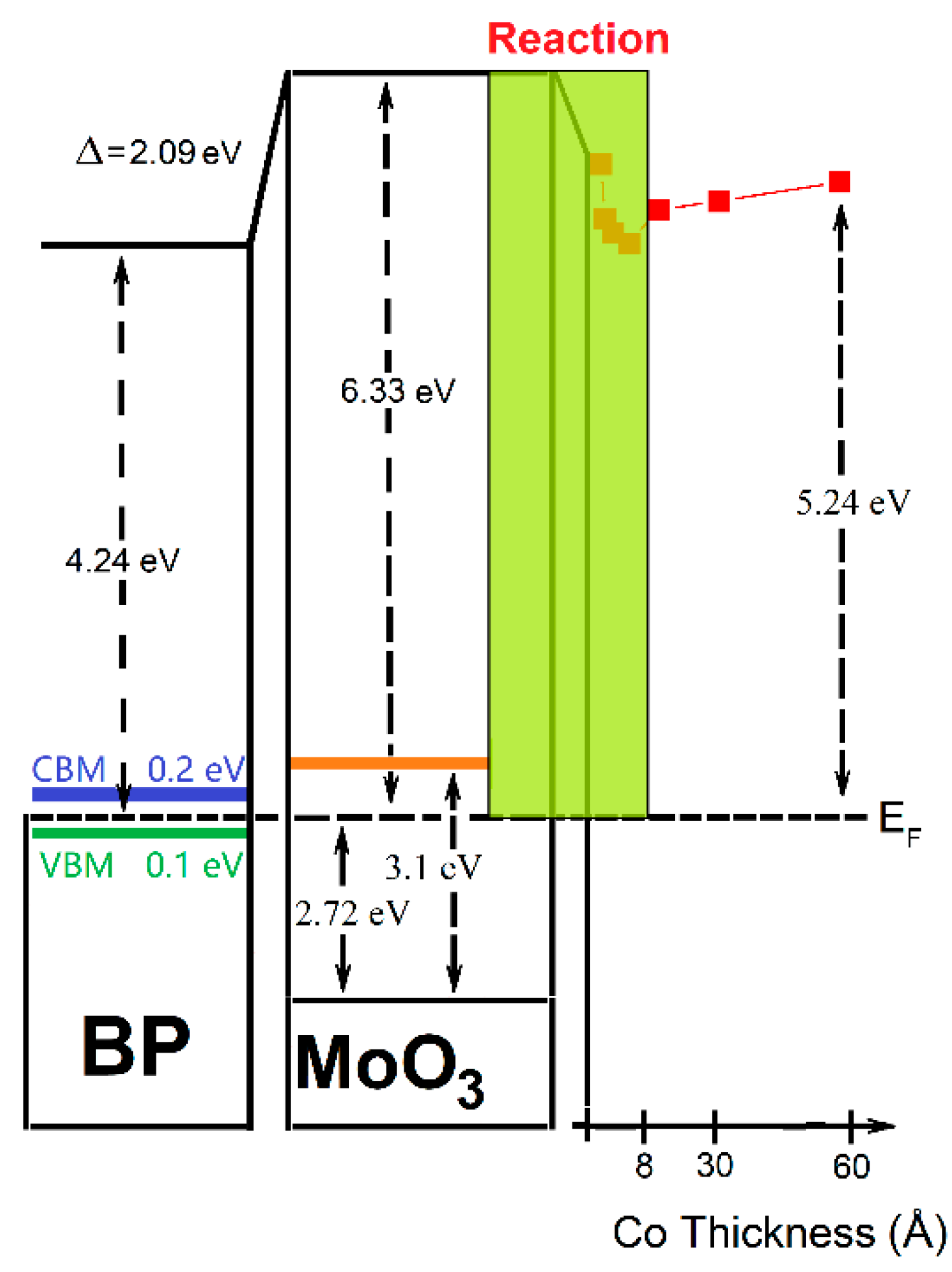
Publisher’s Note: MDPI stays neutral with regard to jurisdictional claims in published maps and institutional affiliations. |
© 2022 by the authors. Licensee MDPI, Basel, Switzerland. This article is an open access article distributed under the terms and conditions of the Creative Commons Attribution (CC BY) license (https://creativecommons.org/licenses/by/4.0/).
Share and Cite
Liu, B.; Xie, H.; Zhao, Y.; Niu, D.; Gao, Y. MoO3 Interlayer Modification on the Electronic Structure of Co/BP Interface. Symmetry 2022, 14, 2448. https://doi.org/10.3390/sym14112448
Liu B, Xie H, Zhao Y, Niu D, Gao Y. MoO3 Interlayer Modification on the Electronic Structure of Co/BP Interface. Symmetry. 2022; 14(11):2448. https://doi.org/10.3390/sym14112448
Chicago/Turabian StyleLiu, Baoxing, Haipeng Xie, Yuan Zhao, Dongmei Niu, and Yongli Gao. 2022. "MoO3 Interlayer Modification on the Electronic Structure of Co/BP Interface" Symmetry 14, no. 11: 2448. https://doi.org/10.3390/sym14112448
APA StyleLiu, B., Xie, H., Zhao, Y., Niu, D., & Gao, Y. (2022). MoO3 Interlayer Modification on the Electronic Structure of Co/BP Interface. Symmetry, 14(11), 2448. https://doi.org/10.3390/sym14112448








